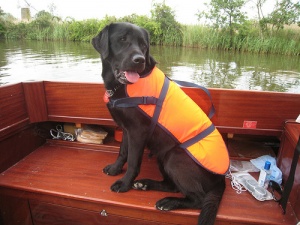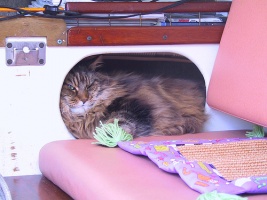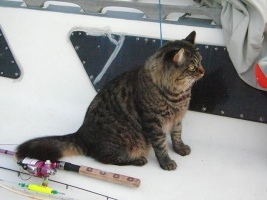Pets Aboard
From CruisersWiki
Going to Sea with Pets Aboard
Sailors have sailed with dogs and cats aboard for hundreds of years. For example, dogs have long been popular mascots in the United States sea services for their ability to build morale. In the early days, dogs often served a more practical function by leading patrols onto foreign shores to search for food and warn of any dangers lurking out of eyesight. But mostly, dogs provided welcome relief from the monotony of being at sea for months on end. The ship's cat has been a common sight on many trading, exploration, and naval ships, and is a phenomenon that goes back to ancient times. Cats have been carried on ships for a number of reasons, the most important being to catch mice and rats. These rodents, when aboard, could cause considerable damage to ropes and woodwork. More serious was the threat rodents posed to the stores the ship carried. Not only could they devour the foodstuff carried to feed the crew, they could cause economic damage if the ship was carrying grain or similar substances as part of its cargo. Rats and mice were also sources of disease, an important consideration for ships which could be at sea for long periods of time. Cats naturally attack and kill these rodents.Cats have a high ability to adapt to new surroundings, and were therefore highly suitable for service on a ship. They also offered companionship and a sense of home and security to sailors who could be away from home for long periods.
Famous ship's pets include Mrs. Chippy was the ship's cat aboard Endurance, the ship used by Sir Ernest Shackleton for his Imperial Trans-Antarctic Expedition. When the ship was lost, having become trapped and eventually crushed in pack ice, the sled dogs and Mrs. Chippy had to be put down, as they would not have survived the arduous journey ahead.
Trim was the ship's cat on a number of the ships under the command of Matthew Flinders during voyages to circumnavigate and map the coastline of Australia during 1801-03. He became a favourite of the crew and was the first cat to circumnavigate Australia. He remained with Flinders until death. A statue to Trim was later erected in his honour, and he has been the subject of a number of works of literature. A statue sits on a window sill on the outside of the Sydney Library, in Sydney, Australia.A much-traveled cruising cat was Miles and Beryl Smeeton's cat Pwe. For many years, during the 1950's-1960's she sailed aboard the Smeeton's 46-foot ketch Tzu Hang. Pwe was a blue eyed Siamese female. She is first mentioned in writing by the Smeetons in 1956 during travels in the South Pacific; she accompanied the Smeetons on many voyages, Miles once said that 'Pwe must be the saltiest cat on record.' She ultimately sailed with the Smeeton family for a total of approximately 130,000 miles. She completed a circumnavigation and many additional adventures. Pwe fell overboard without a PFD more than a thousand miles from land but was rescued by Mrs. Smeeton, an excellent swimmer. Miles Smeeton wrote several books about their adventures on Tzu Hang and life in Canada afterwards. After her full life of voyaging and retirement in the late 1960's, Pwe lived with the Smeetons in Canada for several more years before dying in 1975 at approximately 20 years of age.
Sailing with Pets Today: An Introduction
Many people don’t sail with pets because they don’t believe it is possible that their beloved pets can be comfortable aboard while underway. However, if the pet owner knows how to prepare and take care of their animal, then the family pet can happily cruise. Cruisers simply must undertake the same care to protect their pet from harm as they do in a land-based home. The extra safety precautions are similar for pets and other "non-sailors". Efforts are taken to make sure they don’t fall overboard, to have the ability to retrieve them back aboard if they do go over, preventing seasickness, hypothermia, heat exhaustion, and having appropriate first aid remedies to handle an injury while away from land.
Safety
Pet-flotation devices (PFDs) are available for cats and dogs of all sizes. Once you have purchased one that your pet will wear, give it a test run in the water to let the pet become familiar with how it feels and then walk with your pet wearing the PFD into a calm and safe body of water to make sure the PFD provides adequate support for your pet. To keep track of a pet after dark, attach a light to its harness or PFD. A red light won’t impact night vision. A flashing strobe activated by water can be attached to the PFD as well.
If you will be traveling to strange ports, get your pet an ID tag. Include your boat’s make and model, name, registration number, and a contact number. Some countries also require pets to have a microchip implanted that carries coded information about the pet, its vaccination history, and its owner. Microchip-ing the pet is a good idea even if your home country does not require it. Make sure you have a photo of your pet to show around should your pet go missing.Life Aboard
Make sure that your vessel has adequate provisions to keep your pets comfortable: you must provide them with food, water, protection from the elements, and a safe place to rest.
Seasickness
Motion sickness is thought to be the result of a conflict between visual information and other sensory information relating to the ability to balance. Seasickness occurs in some degree in all the higher vertebrates. Explorer Shackleton had ponies with him as he explored Antarctica and he made note in his logs that they suffered considerably from seasickness during stormy weather. Motion sickness is characterized by nausea, excessive salivation, and vomiting, and affected animals may have other signs referable to stimulation of the autonomic nervous system. Animals may yawn, whine, and show signs of uneasiness or apprehension; severely affected ones may also have diarrhea. Motion sickness is usually seen during travel by land, sea, or air, and signs usually disappear when vehicular motion ceases. Many animals, including people, may be affected.
The principal causative mechanism involves stimulation of the vestibular apparatus in the inner ear, which has connections to the emetic center in the brain stem. Fear of the vehicle may be a contributory factor in dogs and cats, and signs may be seen even in a stationary vehicle. Dealing with and Treating seasickness: In some cases, motion sickness can be overcome by conditioning the animal to travel. In others, ataractic and antinausea drugs can be used with good results. Antihistamines (such as diphenhydramine hydrochloride, dimenhydrinate, meclizine, and promethazine hydrochloride) prevent motion sickness, provide sedation, and inhibit drooling. The centrally acting phenothiazine derivatives (such as triethylperazine, chlorpromazine, prochlorperazine, and acepromazine maleate) have antiemetic as well as sedative effects. Cats have no histamine receptors in the CRTZ; therefore, antihistamines are ineffective in treating motion sickness in this species. Motion sickness in cats probably is best treated with an α-adrenergic antagonist (eg, chlorpromazine) instead of a pure H1-histaminergic antagonist. Phenobarbital and diazepam have been used to produce a general sedative effect. Oral administration of one of these drugs several hours before departure should reduce or eliminate the signs of motion sickness.
Sunburn
Pets are susceptible to sunburn. In most cases, hypoallergenic sunblocks work as well on pets as they do on humans. The likelihood of sunburn can be further increased if your pet is taking certain drugs or medications—antibiotics, tranquilizers and diuretics. To avoid serious sunburn to a particularly vulnerable area, such as a scar, cover it with either sunscreen lotion or use zinc oxide. Sunburn is more likely when the skin is wet so after swimming, be sure to dry your pet as thoroughly as possible. Then reapply sunscreen. Animals’ eyes are extremely vulnerable to sun damage, as is the thin skin of their eyelids. If your pet does get sunburned, the first thing you can do to treat it is cool down the skin. A home remedy is to make a mixture of either 3 tablespoons of baking soda blended in 1 quart water, or 1 tablespoon of rubbing alcohol mixed into 2 cups cold water and to spray or splash this onto the skin. After your pet's skin has cooled, you can coat the sunburned areas to prevent the painful burning sensation caused by oxygen coming in contact with the skin. For this, aloe vera gel is a traditional remedy. It contains a natural painkiller that works as well on animal skin and aids in the healing process. Plain honey, mayonnaise, and petroleum jelly have been cited to work equally well. However, you must keep your pet from licking off these things, as the abrasive action of its tongue can further damage the sore tissues and will make the area hurt more. Many pet owners keep an Elizabethan collar of the correct size for their pet's use. If blisters form on the sunburned skin, treat them in a timely fashion against potential infection.
Entering Foreign Countries With Pets
Many countries have strict health, quarantine, agriculture, wildlife, and customs requirements and prohibitions. Check with the embassy and consulate for the country of interest before travel.
When you travel, it is important to have all your pet's health records with you and in order even if you are in your home country. Group all the required vaccination, test, and vital information about your pet in one place. This makes it convenient for officials to verify your pet's health and inoculation records. Depending on which foreign countries you will visit, your pet's documentation needs vary. Your veterinarian can help pull together the right documentation for your pet to enter countries worldwide. Each country establishes its own rules for entry of animals. You will need to meet the requirements of the destination country. Some countries require a specific health certificate they have developed. Some countries require your pet to use your own country health certificate (if you are coming from the USA, this would be the US-origin international health certificate APHIS FORM 7001 ("United States Interstate & International Certificate of Health Examination for Small Animals").
For example, if you are coming from the United States and are visiting most European Union countries, then the pet health record will consist of the following: The EU Form 998 for the country you will be visiting (they are all different) completed by your veterinarian and certified by the State USDA veterinarian. Your pet's inoculation record which must be attached to the certified EU form 998. (The inoculation record should include the Rabies Certificate)
If you are coming from the United States and visiting one of the United Kingdom countries ( England, Ireland or Scotland) or Norway or Sweden, there will be two more documents required: The results of your pet's blood titer test for Rabies. The Ticks & Tapeworms treatment form.
For other countries, the rules vary widely from country to country. In any case, you should have a Health Certificate completed by your veterinarian prior to your passage. This certificate is also referred to as a Veterinary or Sanitary Certificate. Some countries require very specific inoculations and some require an import permit. Additional information may be obtained via the country specific links below, via your veterinarian, or via the embassy or consulate of the country of interest.
The countries of the world may be segregated into three classifications concerning pets: rabies free countries, low incidence of rabies, and countries with high incidence of rabies. Low incidence of rabies countries include all the countries of the European Union (EU) except the United Kingdom which is rabies free. The United States, Canada, Mexico are also considered low incidence countries. Before your next passage, it is important that you are aware of the classification of the country you are presently visiting for extended stay (this is not necessarily your home country) and the rabies classification of the destination country (where you end this passage). Advance planning can usually allow your pet to avoid being quarantined.
- Rabies Free Countries
- The requirements for entry into these countries may involve a Blood Titer Test depending on the originating country. Antigua, Australia+, Barbados, British Virgin Islands, Cayman Islands, England, Fiji, French Polynesia, Guam, Hawaii, Iceland, Ireland, Jamaica, Japan, Malaysia, Malta, New Caledonia, New Zealand+, Republic of Ireland, Saint Lucia, Scotland, Singapore, Sweden, St. Kitts and Nevis, St. Vincent and The Grenadines, Taiwan, Turks and Caicos Islands, United Kingdom (England, Scotland, Wales, Northern Ireland, Isle of Man), Uruguay, Vatican. +NOTE: Australia and New Zealand are considered to be low incidence countries by the European Union, and rules for entry are different than for rabies free countries. Also, note that some islands are considered Rabies Free while the country itself is not, an example is the US state of HI.
- Countries with a High Incidence of Rabies
- Afghanistan, Bahamas, Belize, Brazil, Cambodia, China, Colombia, Costa Rica, Dominican Republic, East Timor, Georgia, Ghana, Greenland, Honduras, India, Indonesia/Bali, Iran, Iraq, Israel, Jordan, Kazakhstan, Korea (North and South), Kuwait, Laos, Lebanon, Libya, Macau, Maldives, Mongolia, Myanmar (Burma), Nepal, Nigeria, Omar, Pakistan, Palestine, Panama, Papua New Guinea, Philippines, Qatar, Saudi Arabia, Serbia, Seychelles, South Africa, Sri Lanka, Sudan, Syria, Thailand, Turkey, Ukraine, Uruguay, Uzbekistan, Yugoslavia, Vietnam, Yemen, Zimbabwe.
- Other countries are considered to have "Low Incidence of Rabies"
- Here is a general guideline regarding travel between various of the above country cases (RABIES FREE, HIGH INCIDENCE, LOW INCIDENCE) however, the situation may be different for the country you are traveling from and to. Please verify all information is current with the embassy and consulate ahead of time.
- From a RABIES FREE COUNTRY to a ANY OTHER COUNTRY (except certain other RABIES FREE COUNTRIES) you should be able to enter with the minimum of paperwork and without quarantine or a blood titre test although some countries will require an import permit. There may restrictions and perhaps possible quarantine when returning.
- From one LOW INCIDENCE to another LOW INCIDENCE country the pet must have resided in a LOW INCIDENCE country for a minimum of six months prior to your departure date. Some countries will require a microchip and the proper veterinary certificate for the country that you are entering. Your dog or cat rabies vaccinations must be current. There are a limited number of the LOW INCIDENCE country that also require an import permit for entry.
- From a LOW INCIDENCE to a EU COUNTRY the pet must have resided in a LOW INCIDENCE country for a minimum of six months prior to your departure. The pet will need a 15 digit ISO pet microchip for some countries and the EU form 998 Veterinary Certificate for the country that you are sailing to. Your dog or cat’s rabies vaccinations must be current. A few EU Countries also require a Blood Titer Test.
- From a LOW INCIDENCE country to a RABIES FREE COUNTRY, a blood titre test, microchip as well as the proper pet health records for the destination country is required. There is always a waiting period from the time you have the blood titre test until the time you enter the RABIES FREE country of between 120 days and 180 days. The blood titre test is valid for two to three years though. If your schedule does not allow for the waiting period to be completed, quarantine will be imposed at the destination country.
- From a LOW INCIDENCE to a COUNTRY WITH A HIGH INCIDENCE OF RABIES requires the proper pet health records and sometimes an import permit. These countries do not require a blood titre test and most do not require a microchip. You may have a problem returning to a LOW INCIDENCE or a RABIES FREE COUNTRY.
- From a COUNTRY WITH A HIGH INCIDENCE OF RABIES to a LOW INCIDENCE country, with a few notable exceptions such as the USA and Canada, anytime you travel from a country with a HIGH INCIDENCE OF RABIES to a LOW INCIDENCE country, a blood titre test will be required, your pet must be micro chipped and you will need the proper pet health records forms for that country.
- From a COUNTRY WITH HIGH INCIDENCE OF RABIES to another COUNTRY WITH A HIGH INCIDENCE OF RABIES usually you will need only the proper pet health records forms and sometimes an import permit.
- There are important CASES TO NOTE: If you try to bring your pet from a country with a HIGH INCIDENCE of rabies to the United Kingdom, then you will either be refused entry, or your pet will be placed in quarantine for a period of six months. There are several countries where quarantine is unavoidable unless you are entering from a RABIES FREE COUNTRY.
Procedures and Regulations
The cruising wiki's country, island, and destination pages include information about bringing pets into the country of interest.
References
- Sailing Ships.
- Dogs and the Sea Services US Naval Institute. Retrieved Sept 8, 2012
- Purr-n-Fur
- Merck Veterinary Manual
- Travel with Pets
Forum Discussions
External Links
- Sailing Friends of the Four Legged Kind
- Hawaii Animal Quarantine Requirements
- US Department of State Travel Tips
Personal Notes
| |
|---|
|
Names: Redbopeep |





